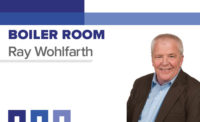The appointment with the specifying engineer did not go well. I proudly showed him the information about the boilers that I represent and he handed the material back to me and said: “Boilers are dead. No one uses them anymore. I am really busy.” I thanked him for his time, called him a jerk in my mind and left.
During the drive back to the office, I thought about the future of boilers. Was the engineer correct? Are boilers dead? Am I selling dinosaurs? I am reminded of this famous quote from the “Monty Python and the Holy Grail” movie: “I’m not dead. I’m getting better.” I believe boilers are still a great heating system and will share my reasons.
1. Longevity.I recently purchased a 40-year-old home with a forced-air furnace for the first floor and a hydronic boiler with baseboard heat for the second floor. The furnace is the second one for the house and is in need of replacement again. The boiler is original, still works great, and is 78.9% efficient. Yes, I checked it with my combustion analyzer.
2. Efficiency.The first floor heat in the house is drafty, noisy and uncomfortable. I thought balancing the airflow would allow me to increase the comfort in my home. I measured the cubic ft. per min. of air at each register and was shocked because the total airflow was only 58% of the capacity of the furnace.
I double-checked my readings and got the same answer. My 80% efficient furnace was only about 50% efficient. If my hydronic system leaked as much water as the forced-air system leaked air, I would have a flooded house. I realized that the duct was installed by the low bidder at a time when energy was cheap, so duct air leakage was customary.
3. Maintenance costs.The 40-year-old boiler requires very little maintenance. A few drops of oil in the pump and verifying the operation of the safety controls is all that is required. As a precaution, I replaced the $10 thermocouple.
4. Simple or complex?You decide. I belong to the Radiant Professionals Alliance and each year they have a design contest showing the installation skills of hydronic artists. These systems have more zones than I can count and look like a giant copper octopus. It is truly amazing.
I realize that while some people have the brain cells to design something as complex as these systems, I like hydronics for the simplicity. The boiler in my home provided comfortable, efficient and safe heating, all with low maintenance for almost a half century. A hydronic system can be as simple or complex as you desire.
5. Versatility.“What about cooling? You can’t do cooling,” a smug installer of furnaces will often point out in my seminars. I agree that while a boiler cannot provide cooling (some absorption chillers use hot water or steam to produce cooling), a single boiler can supply heat for the building, domestic hot water and swimming pool, or melt the snow from the sidewalk or driveway all at the same time.
On the buildings that use a boiler for space heating, I have had success installing a ductless mini split or a cooling-only air-handling unit. We are seeing some fascinating projects using radiant cooling in some of the trade magazines which can be installed using PEX tubing. Did you know that a 1-in. pipe can transport the same amount of Btu as a 14-in. round duct?
While I prefer the boiler side of the business as there are fewer competitors, I am a realist. My company sells and services as many packaged rooftop units as we do boilers because they have about 90% of the commercial market here. I provide what the client wants.
6. Backup heat.My first house had a one-pipe steam system that used a powerpile gas valve, which does not require electricity to operate. The thermocouple or thermopile in the pilot flame generates a millivolt current to power the gas valve. Since it was a steam system, it did not require electricity to distribute the heat.
While my neighbors with standard boilers and furnaces had no heat during the frequent winter power outages, my house was warm and toasty. All the neighbors would send their kids over to my house to stay warm. The one drawback was that our grocery bill was higher because we had to feed those kids.
7. Btu meters.A commercial client of mine uses Btu meters on his hydronic system to calculate the heat consumption for his tenants, allowing him to accurately charge each one for their usage. It is less expensive than installing separate HVAC units and meters for each tenant.
8. Unparalleled comfort.Do you remember the story of Goldilocks and the Three Bears? Each porridge dish was a different temperature. You can do the same thing with hydronics. A client told me he loves the hydronic system we installed in his house with individual room controls because he can have a different temperature or even climate for each room. His wife likes it Tropical Rain Forest while his teenage son prefers Siberian Winter.
9.Installed cost. Many of the new hydronic systems can be installed using PEX tubing, making the installation much easier to install than the old pipe systems were. We retrofitted a house in my area and were able to install homeruns to each room to allow isolation. Balancing was a snap.
10. Safety.Each year, we hear about people who are overcome by carbon monoxide due to a cracked heat exchanger. The boiler does not have an air-to-air heat exchanger like a furnace. If the heat exchanger fails, it will leak water, which is easy to see. While boiler explosions seem to grab the headlines, many more people are overcome by carbon monoxide poisoning from household appliances than are injured in boiler accidents.
“I’m not dead. I’m getting better.” I believe this should be the mantra for boiler fans everywhere. Boilers can still provide a comfortable, cost-effective heat for our clients.
This article was originally titled “Rest in peace, boilers!” in the March 2015 print edition of pme.
HELPFUL LINKS:



